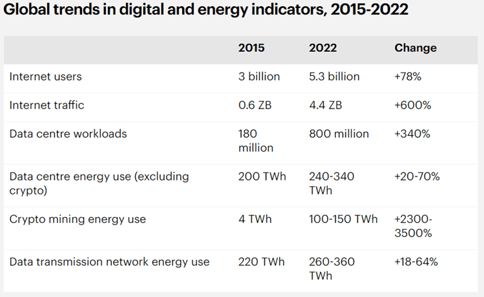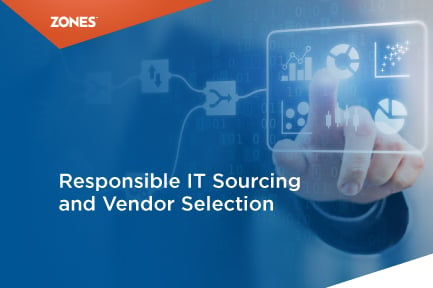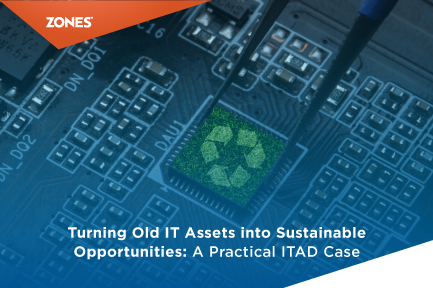5 Dos and Don'ts of Sustainable IT Sourcing and Vendor Selection
Technology today has become an integral part of our lives, driving innovation and shaping how we live and work. However, as our reliance on...

In today's rapidly evolving world, sustainability has become a non-negotiable aspect for every industry. The significance of adopting sustainable practices extends beyond reducing environmental impact; it now plays a pivotal role in ensuring long-term success and staying competitive in the market. The recognition of IT's environmental impact and the urgency to address it is growing.
The global call for sustainability has permeated every industry, with IT playing a pivotal role in this paradigm shift. As society becomes more environmentally conscious, consumer preferences shift toward businesses embracing sustainability. Studies indicate that many consumers prefer supporting brands committed to reducing their carbon footprint and implementing eco-friendly practices.
Adopting sustainable IT practices is an ethical choice and a strategic move for organizations. However, for organizations, navigating the path to sustainable IT success can be daunting due to the rapidly evolving nature of technology and limited resources.
This blog aims to provide organizations with practical insights and actionable steps to integrate sustainability into their IT operations, paving the way for a greener and more efficient future.
Setting sustainability goals and creating a comprehensive action plan is crucial for organizations aiming to achieve sustainable IT success in 2024. This involves a structured approach to aligning efforts toward reducing environmental impact and promoting social responsibility.
Here are 6 ways to achieve sustainability in 2024:
Implementing energy-efficient hardware and software solutions is essential for organizations seeking sustainable IT success in 2024. With a growing emphasis on environmental conservation and rising energy costs, adopting energy-efficient technologies is imperative for reducing both carbon footprints and long-term operational costs.
Energy-Star-Rated Devices:
Start investing in energy-star-rated devices designed to consume less power without compromising performance. These include energy-efficient desktops, laptops, servers, and networking equipment meeting strict criteria the Environmental Protection Agency (EPA) has set.
Optimizing Software Solutions:
Software optimization plays a crucial role in energy efficiency. Virtualization technology, for instance, allows running multiple virtual machines on a single physical server, reducing the need for additional hardware and lowering energy consumption.
Power Management Features:
Implement power management features on devices, such as enabling sleep or hibernate modes, setting automatic shut-off timers for peripherals, and encouraging employees to turn off devices when not in use. These contribute to significant energy savings.
Electronic waste (e-waste) management is a pressing concern in technology-driven businesses. According to Statista, approximately 61.3 million metric tons of e-waste was generated globally in 2023, with only 20% documented as officially collected and recycled.
As organizations upgrade their IT equipment, responsible disposal and recycling become crucial for environmental protection and compliance with legal and ethical standards.
Certified E-Waste Recycling Companies:
Partnering with certified e-waste recycling companies ensures proper IT equipment disposal and recycling. These companies follow strict guidelines, recover valuable resources, and manage harmful substances responsibly, minimizing negative environmental impacts.
Additionally, organizations can partner with a sustainable IT asset disposition (ITAD) service provider for secure data destruction with remarketing and recycling of IT assets.
Eco-Friendly Procurement:
Prioritize suppliers with recognized sustainability certifications. Companies with higher EcoVadis scores (a globally recognized standard for corporate social responsibility) and R2v3 certification (a framework for responsible recycling practices in the IT sector for end-of-life assets) demonstrate better practices of adopting sustainability.
Circular IT Practices: Embrace circular IT practices such as using IT equipment for an extended period; leading/renting the assets; and repairing, refurbishing, and repurposing IT equipment if it is functional. This can considerably reduce the impact of electronic waste on the environment. Organizations can also donate devices in good condition to schools, non-profit organizations, or individuals in need, bridging the digital divide and promoting a sustainable approach to technology.
Optimizing IT operations for energy efficiency is a dual-purpose strategy that aligns with sustainability goals and financial prudence. As the world becomes increasingly aware of the impact of energy consumption, businesses are seeking ways to prioritize environmental conservation while maintaining operational efficiency.
Data Center Efficiency: Data centers are significant consumers of energy. According to the International Energy Agency, global data center electricity consumption in 2022 was 240-340 TWh. This is more than a 20% increase compared to 2015.

Image Credits: International Energy Agency
Businesses can significantly reduce their carbon footprint and operational costs by implementing energy-efficient practices such as consolidation and advanced cooling technologies.
Energy-Efficient Hardware:
Investing in energy-efficient servers, storage devices, and networking equipment can significantly reduce power usage without compromising performance. Power management tools and techniques enhance energy efficiency, such as intelligent power distribution units and automated power-saving modes.
Additionally, transitioning to renewable energy sources can significantly reduce carbon footprints.
Organizations can also implement sustainable IT practices by shifting their on-premise and physical infrastructure to the cloud and adopting virtualization practices.
Cloud Computing:
Migrating IT infrastructure to the cloud is a powerful strategy for minimizing reliance on physical hardware. Cloud-based solutions offer scalability, allowing businesses to adjust computing resources based on demand, optimizing energy consumption. The centralized nature of cloud infrastructure enhances sustainability.
Cloud computing provides organizations with increased flexibility and cost savings. Accessing data and applications from anywhere enables remote work and enhances productivity. The pay-as-you-go model allows organizations to pay only for their resources, eliminating upfront investments in costly hardware and software licenses.
Virtualization:
Virtualization complements cloud computing by consolidating multiple virtual servers onto a single physical server. This reduces the hardware footprint, resulting in energy savings and reduced e-waste. Virtualization also enhances resource utilization, improving overall efficiency and reducing the need for additional hardware investments.
To leverage cloud computing and virtualization for sustainability, organizations should assess their current IT infrastructure and identify opportunities for migration. Collaborating with trusted cloud migration service providers can facilitate a seamless and efficient transition, ensuring businesses reap these technologies' environmental and financial benefits.
Encouraging employee engagement and education in sustainable IT practices is pivotal for organizations' path to sustainable IT success. Sustainability should not be confined to managerial decisions; it requires active involvement at all levels of the organization.
Fostering a Culture of Sustainability:
Creating a culture of sustainability within the organization involves promoting awareness and understanding of sustainable IT practices. Workshops, seminars, and training sessions on sustainability can help employees grasp the concept and its relevance to their work. This can include sessions on energy-efficient computing, responsible e-waste management, and using green technologies.
Sustainability Champions:
Appointing sustainability champions or ambassadors within the company can be instrumental in achieving sustainability. These individuals serve as role models and advocates for sustainable practices, encouraging colleagues to adopt eco-friendly habits and facilitating knowledge sharing.
Recognition and Rewards:
Recognizing and rewarding employees for sustainable contributions creates a positive feedback loop. Establishing a system acknowledging and celebrating sustainable efforts motivates employees to participate actively in the organization's sustainability goals.
To achieve sustainability goals, organizations should align, measure, and monitor their efforts to reduce environmental impact and promote social responsibility. Here are a few ways organizations can set up standard best practices and monitoring practices.
Internal Policies:
Implement internal policies to encourage responsible disposal practices among employees. This includes educating staff on the importance of e-waste management, providing clear guidelines on proper disposal, and establishing collection points within the workplace for organized recycling.
Audit and Analysis:
Regular audit and analysis of energy consumption provide insights into areas of improvement. Energy management software and energy audits help identify energy usage patterns, allowing businesses to make informed decisions and optimize IT operations accordingly.
Measuring and Tracking:
Measuring and tracking the progress toward sustainable IT success is crucial in ensuring that your efforts are making a real impact. Some key metrics are monitoring energy consumption, e-waste disposal, carbon footprint, and emissions. Without proper measurement and tracking, it can be challenging to determine if your sustainability initiatives are adequate or if adjustments need to be made.
In the face of technological evolution, prioritizing sustainability in IT strategies is inevitable for long-term success. Embracing sustainable IT practices allows organizations to reap the benefits of reduced costs, enhanced brand image, and future-proofed operations. Initiatives such as energy-efficient hardware, virtualization, responsible e-waste management, and employee engagement contribute to a positive brand image, attract environmentally conscious customers, and position organizations as industry leaders.
The path to sustainable IT success begins with a commitment to environmental responsibility and adaptability to emerging technologies and trends. By carefully planning and implementing sustainable practices, organizations can harness the advantages of sustainable IT.
If you are ready to embrace sustainable IT, then partner with Zones, a global sustainable technology provider. Zones Technology Solution Centers (TSCs) are R2v3 and ISO 45001 certified. We also lead the circular economy with eco-friendly and energy-efficient packaging, e-waste reduction, and disposal (ITAD) services.
To learn more about Zones sustainability practices, visit Sustainability | Sustainable Technology and Solutions | Zones.

Technology today has become an integral part of our lives, driving innovation and shaping how we live and work. However, as our reliance on...

To stay in the market, organizations constantly work towards enhancing their technology as it is required in the current era. This comes with a...

Climate change and environmental issues are major global challenges. This is why there is a growing recognition to mitigate the environmental impact...